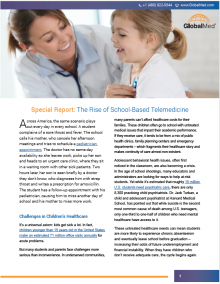 While most people associate telehealth services with clinical settings, telemedicine is revolutionizing an unexpected environment these days: schools. Virtual health solutions are becoming standard in both the traditional nurse’s office and school-based health centers (SBHCs) and they’re treating a rising number of children.
While most people associate telehealth services with clinical settings, telemedicine is revolutionizing an unexpected environment these days: schools. Virtual health solutions are becoming standard in both the traditional nurse’s office and school-based health centers (SBHCs) and they’re treating a rising number of children.
Here’s why telemedicine programs are so effective in schools. Virtual care can connect students to pediatricians, specialists and their parents in the same visit, which solves two issues rampant in children’s health: inconvenience and access to care.
The Conundrum of Student Healthcare
Let’s look at the first challenge. Inconvenience might not sound like a big deal until you realize that children younger than 15 years old in the United States make an estimated 71 million office visits annually for acute problems. When they get sick at school, their parents have to leave work, pick them up and take them to their pediatrician’s office (if they’re lucky enough to get an immediate appointment) or an urgent care center. Kids with chronic conditions can have even more frequent medical needs, leading them to miss out on both classroom time and peer relationships because they’re always at the doctor’s office.
Access to care is an even bigger problem. Many children don’t receive consistent – or any – medical care due to overburdened parents, economic hardships, transportation challenges, and provider shortages. Untreated healthcare issues can increase absenteeism and impact their academic performance. Without a way to procure their own care, their only hope is an intervention at school.
Telemedicine can help connect kids with resources to primary and specialty care. Children from low-income, rural and other vulnerable communities can receive consistent quality care even when their home environments are unstable – setting them on the road to more promising academic and professional futures.
School-Based Health Centers and Telemedicine
SBHCs are some of the biggest providers of virtual services. Thousands operate across the United States near or on school campuses, offering integrated medical and behavioral care from pediatricians, certified nurse practitioners, drug counselors, dietitians and other clinicians. Without leaving school grounds, students may seek help for a sore throat or an ankle sprained in gymnastics. Chronic disease management can keep kids with diabetes or asthma in class. Dental and vision care, vaccinations, counseling and other preventive services can help students avoid serious illness and academic failure.
By using telemedicine, many SBHCs are seeing the following benefits:
1. Student illnesses and injuries are treated immediately, minimizing the contagion factor and lost classroom time.
2. Primary care providers can be conferenced into the school session, improving care coordination.
3. Students who normally wouldn’t receive behavioral, dental or medical care can be treated regardless of transportation or socioeconomic challenges.
4. Parents can participate in the virtual visit without leaving work or trying to schedule a pediatrician appointment.
5. Counseling can help kids focus better in class, treat childhood obesity and depression, and avoid social isolation.
6. Children can maintain steady treatment plans even if they’re at summer camp, childcare centers, after-school activity clubs, juvenile detention centers or traveling with their families.
7. Students with consistent care perform better in class and are more likely to graduate from high school.
School Telemedicine Grants
Like any provider, schools and SBHCs can seek reimbursement from Medicare, Medicaid and commercial insurance carriers for services provided. But because they often provide care to students without insurance, most school-based telemedicine deployments depend on local, state and federal agency grants.
To help SBHCs better navigate the grant and reimbursement landscape, we’ve created a new special report on school-based telemedicine. Our report explains the benefits an efficient school telehealth program can offer, how they function and includes a list of grant resources.

